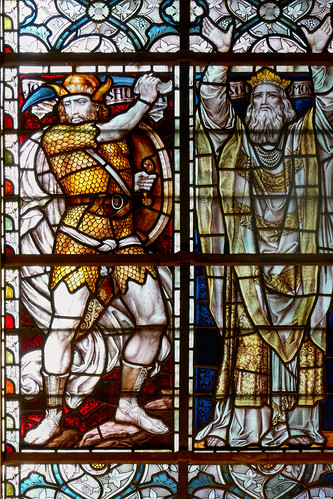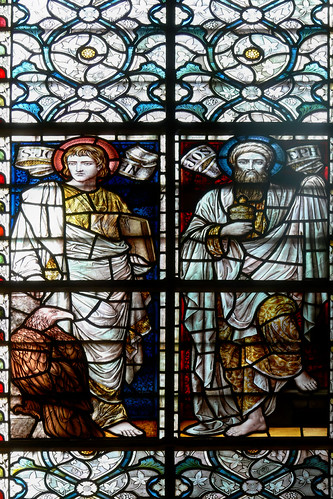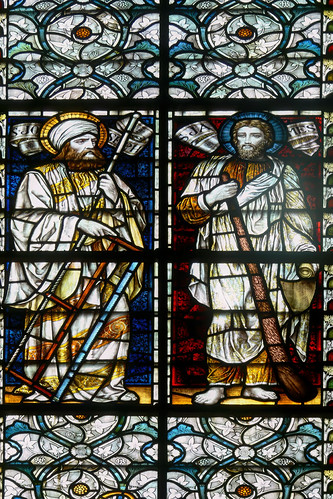Saints and Patriarchs - Salisbury Cathedral
The sequence of stained glass windows depicting the male saints and patriarchs of the Bible, designed by Henry Holiday and made by James Powell & Sons (Whitefriars Glass) in 1891, forms one of the most coherent and dignified ensembles within Salisbury Cathedral’s late Victorian glazing scheme. Conceived as a companion cycle to Holiday’s Women of the Bible series, these four windows present eight figures, Jacob and Moses, Joshua and Solomon, Saint John and Joseph of Arimathea, and Saint Joseph and Saint James the Less, each pair embodying a distinct aspect of divine calling and human virtue.
Unity of Design
Throughout the series, Holiday’s design language remains disciplined and harmonious. Each pair of figures stands within richly ornamented Gothic canopies, framed by floral and geometric tracery that integrates the glass with the cathedral’s architecture. The figures are modelled with sculptural subtlety, their expressions serene and introspective. Alternating blue and red backgrounds provide both rhythm and theological resonance, blue signifying divine wisdom and contemplation, red symbolising sacrifice and zeal. The muted opalescence of the drapery, often patterned with delicate gold and ivory, reflects the Arts and Crafts ideal of beauty fused with moral purpose.
Themes and Meanings
Each window explores a complementary pair of virtues:


-
Jacob and Moses represent revelation and law, the striving of humanity toward divine understanding and the giving of divine order to humankind.
-
Joshua and Solomon express strength and wisdom, the courage to lead and the discernment to rule.


-
Saint John and Joseph of Arimathea embody witness and devotion, those who stood by Christ in His passion and testified to His divinity.
-
Saint Joseph and Saint James the Less evoke obedience and perseverance, faith expressed in humble service and steadfast endurance.
Together, these eight figures form a meditation on leadership, fidelity, and revelation, tracing the moral arc of Scripture from patriarchs and prophets to apostles and saints.
Artistic and Theological Harmony
Holiday’s interpretation avoids drama in favour of quiet authority. Each figure stands as a moral exemplar, rendered with the dignity of classical form and the spiritual introspection of the Pre-Raphaelite tradition. The faces are calm, the gestures measured, and the colour harmonies restrained yet radiant. In their unity of design, these windows embody a distinctly Victorian theology of vocation, faith realised through action, wisdom through contemplation, and holiness through service.
Overall Impression
Viewed as a whole, the Male Saints and Patriarchs cycle complements the Women of the Bible series as its masculine counterpart. Where the female figures embody faith, love, and devotion, these windows proclaim wisdom, courage, and duty. Together they form a complete vision of Christian virtue, expressed through light, line, and colour.
Executed at the height of Henry Holiday’s collaboration with James Powell & Sons, the cycle stands as one of the most eloquent achievements of late nineteenth-century ecclesiastical art, a serene synthesis of craftsmanship, theology, and beauty, uniting the human and the divine in the radiant language of stained glass.
